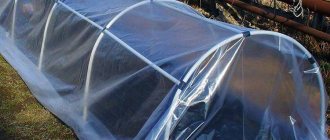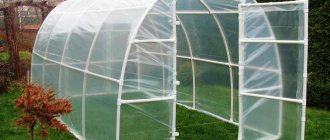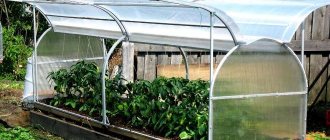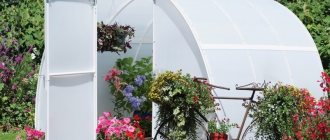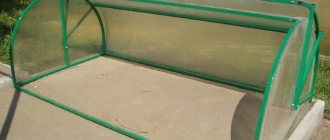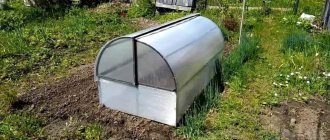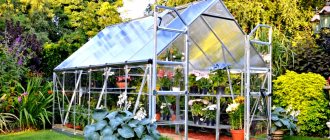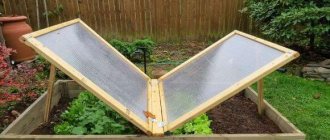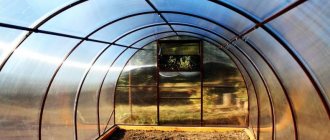The profitability of polycarbonate greenhouses on a metal frame raises huge doubts among most buyers. Which is not surprising, given their high cost including production, delivery and assembly on site, as well as the cheap cost of seasonal vegetables. They are only profitable if used to grow large volumes of produce for sale. If you are engaged in gardening “for yourself”, it is enough to learn how to make a greenhouse from plastic pipes with your own hands: it will cost less and will cope perfectly with the tasks assigned to it.
Homemade greenhouse made from pipes and film Source i.ytimg.com
Which pipes are suitable for building a greenhouse?
When it comes to plastic pipes, we can mean products made from different materials: polyvinyl chloride (PVC), polypropylene (PP), polyethylene (HDPE and LDPE), etc. They have many similar characteristics, but there are also differences that primarily affect the choice of application.
The main purpose of such pipes is the installation of pipelines for pumping various liquids from drinking water to petroleum products. Some of them tolerate high temperatures better than others, while others are more mechanically durable. But all these and other parameters are important to consider only when using such pipes for their intended purpose.
Almost all types of plastic pipes are suitable for the manufacture of greenhouses and greenhouses, but PP and PVC are most often used, since making a greenhouse from polypropylene pipes will cost much less, and the structure will be more stable due to the rigidity or large thickness of the walls of the products. Polyethylene pipes do not have these qualities.
However, ordinary white PP pipes are gradually destroyed by exposure to ultraviolet radiation. For a greenhouse, it is better to take gray ones with a UV filter or protect regular ones with a layer of paint.
Polypropylene pipes of different diameters Source recyclingprom.ru
Other parameters also influence the choice:
- Flexibility of pipes is necessary for creating structures from arcs. This is to a greater extent possessed by products made of polypropylene, while it is easier to make a greenhouse from PVC pipes with vertical walls and a pitched roof due to their rigidity;
- Diameter - pipes with a cross-section of more than 25 mm are quite difficult to bend into a standard arc;
- Length - it is also selected depending on the shape and size of the future structure, which is especially important for arched greenhouses: it is easier, faster and cheaper to make a frame arch from one solid pipe, and not from 2-3 that will have to be joined;
For reference! Most often in stores you can find products with lengths of 2 m, 4 m, 5 m and 6 m. The sizes depend on the manufacturer.
- Connection method . Polypropylene pipes are welded with a special soldering iron using inexpensive fittings made of the same material, and polyvinyl chloride pipes are connected by gluing. For PP, you can also use detachable threaded fittings, but they are not cheap. While it is not necessary to glue PVC to create a greenhouse frame, since the tightness of the connections is not needed here. You can simply assemble the structure and, for reliability, secure the joints with self-tapping screws instead of glue.
If necessary, the self-tapping screws can be unscrewed and the frame disassembled Source remoo.ru
In the case of making temporary small-sized greenhouses, they do not pay attention to the recommended connection method, since you can make a greenhouse from plastic pipes with your own hands by connecting the nodes with tape, electrical ties or wire, fixing the elements with them at their intersections. Collapsible structures can be connected with long furniture bolts, drilling through holes for them immediately through two pipes at the place of their intersection.
HDPE pipes are also used in the manufacture of film mini-greenhouses for growing seedlings or rooting cuttings. It is impossible to build a tall structure from them, but it is quite possible to temporarily cover the bed during the period of frost, using scraps left over from laying the water supply system.
Arches from HDPE pipes Source maja-dacha.ru
Regardless of the type of polymer from which the pipes are made, they all compare favorably with metal ones in their more affordable price, ease of transportation, corrosion resistance and durability without the use of additional protective agents. And their low weight simplifies the work of building the frame and makes it easy to move the finished structure from one bed to another. Of course, if the greenhouse design allows it.
Plastic arches
Greenhouses made on the basis of plastic arcs can be increasingly seen in gardening areas. The fact is that since plastic has firmly entered our lives, it is used almost everywhere. It is light, cheap, easy to process - what else is needed to build various structures from it with your own hands? That’s why greenhouses on plastic frames appeared at dachas.
Tunnel greenhouse with plastic arches
Plastic arches are good because they are not afraid of corrosion, which means they will withstand snow, heat, and torrential rain. This explains their durability.
Greenhouse with clips for arcs
Plastic is also very light, and a greenhouse made on the basis of such arcs can be easily assembled, carried and installed by anyone - even a child. True, plastic arcs are usually used only to create small structures.
Arches made of polyethylene pipes
One of the main disadvantages of plastic is some fragility. If you apply some effort, the material will crack and break. Although, again, everything is individual here - there is also such plastic that is not afraid of anything at all.
On a note! Arched plastic-based greenhouses can be purchased ready-made. They are usually inexpensive. The trouble with these greenhouses is that often their arcs crack at the bottom, which sticks into the ground.
How to make arcs for a plastic greenhouse? It's simple - there are two main ways. You will need a regular plastic plumbing pipe for water supply and a hair dryer.
Method No. 1
Step 1. Cut the pipe into required lengths.
Cutting plastic pipe
Step 2. While heating each piece of pipe in the middle, carefully bend it to the desired radius.
Heating with a hair dryer
Step 3. Along the perimeter of the bed where the greenhouse will be installed, insert metal or plastic pins in pairs opposite each other. The distance between each pair should be no more than 50 cm.
Plastic pin for fastening the greenhouse
Step 4: Simply slide the arcs onto the pins.
Step 5. At the top, connect the arcs with one straight pipe, securing it with clamps. She will not let the greenhouse collapse.
The arcs are connected by horizontal ties
Another option for attaching arches from pipes
Homemade fastener from an old hose
Method No. 2
It appeared when gardeners realized that the ideal frame for a greenhouse was a combination of metal and plastic. Here the frame installation system is almost the same, except that a metal rod, turned into an arc, is inserted inside each pipe. It looks like metal in a plastic wrapper. This will protect it from excess moisture.
To increase strength, metal rods are inserted inside the plastic arches
What kind of structure can be assembled from plastic pipes?
This question can be answered briefly: almost any, except teardrop-shaped. But before you make a greenhouse from polypropylene pipes with your own hands, it is worth considering all types of structures in order to choose the most optimal option for you:
- The arched type is considered the most stable and reliable, and it is also easier to manufacture. This form is given to both permanent polycarbonate greenhouses on a foundation and temporary or portable film greenhouses.
Arched greenhouse on a foundation Source teplicno.ru
- The pitched type has vertical walls and a roof with one or two slopes. As a rule, permanent structures are made like this, especially when they are attached to the main wall of a house or other building located on the site. But there are also collapsible or portable options.
Homemade portable greenhouse-house Source plodogorod.com
- Greenhouses in the form of a tent or dome are rarely built and usually serve not so much a utilitarian as a decorative function. They are more difficult to manufacture than the two previous designs.
A spherical greenhouse is assembled from triangular elements. Source novamett.ru
The high strength of plastic and its resistance to any weather conditions allows the use of products made from it to construct the frame of permanent greenhouses that are not planned to be moved or put away for the winter. And also for heated structures operated all year round.
And the lightness of the pipes and the ease of their assembly are the very qualities that make it so easy to solve the problem of how to make a greenhouse made of plastic pipes mobile, allowing you to ensure crop rotation in the garden without unnecessary hassle.
Do-it-yourself arches from scrap materials
However, arches or arcs for a greenhouse are made not only from metal or plastic. There are other materials and methods that may be suitable in your case.
Table. What can greenhouse arcs be made from?
| Material | Description |
| Tree | Why not a material for making a frame? It also makes excellent arcs. The problem is that you will have to do a lot of work if you want to get exactly the arcs. Such frame parts are stable, but quite light. The main disadvantage is that the tree can quickly rot in the lower part that sticks into the ground if it is not treated with a special product. |
| garden hose | There's an old garden hose lying around at the dacha, but you can't throw it away? Turn it into a greenhouse! It's simple - thread metal arcs inside the hose sections. Yes, in this case the hose does not itself become an arch, but organically complements the metal arch. The rubber coating will protect from moisture. |
| Willow twigs | Very flexible, but short-lived material. Willow twigs can be used as a temporary frame to create a greenhouse. Often they are just inserted into scraps of an old watering hose. |
| thick wire | It bends quickly even with your hands; you can use it to make temporary arches for a greenhouse. The material is quite soft and suitable for creating a warm house for plants in a hurry. Can't handle strong winds. |
| Old hoops | Ordinary plastic hoops, which all the girls in the country twirled around their waists, are perfect for creating arcs for a greenhouse. Simply cut the hoops in half and use pegs to stick them into the ground. At the top they can be fastened with a wooden block. By the way, this method of creating a greenhouse was popular in the USSR. |
| Old cots and headboards | Does everyone remember the old Soviet folding beds and spring beds with metal headboards? It is these backrests, as well as the legs from the folding beds, that can be used to create a greenhouse. True, it will turn out to be U-shaped. |
Polycarbonate greenhouse
The frame serves as a kind of skeleton on which the entire greenhouse structure rests. Therefore, it is necessary to approach the choice of material here with special care. The most inexpensive and common option is a wooden frame. More details in this article.
Manufacturing options and assembly methods
How to build a greenhouse from plastic pipes with your own hands depends on whether you need a permanent, mobile or collapsible structure, as well as on its spatial shape. In any case, a drawing is first made indicating all the components, dimensions and individual elements (doors, windows), which helps to calculate the required amount of materials.
Scheme of a greenhouse with a gable roof Source teplica-exp.ru
Capital permanent structures
As a rule, if a greenhouse is installed in a permanent place for long-term operation, a foundation is made for it. It can be made of brick or concrete blocks, made of timber treated with a powerful antiseptic, or be a shallow monolithic strip of concrete.
The fastening of the frame to the foundation is selected depending on its type. The easiest way is to fix the posts or arches on a wooden base using clamps or strips of perforated metal tape and self-tapping screws. It will have to be secured to brick and concrete with dowels. And when pouring, “glasses” made of pipes of larger diameter can be installed in the strip foundation, into which the greenhouse support posts will subsequently be inserted.
Even more reliable fastening will be provided by pieces of reinforcement 60-80 cm long, driven into the ground along the outer perimeter of the foundation at an equal distance from each other.
Advice! The distance between the posts of a large greenhouse should be maintained no more than 100 cm, and between the transverse runs no more than 50-60 cm.
How to make arcs for a small structure yourself
For a long time, gardeners have considered greenhouse and greenhouse to be synonymous words, but still there is a difference between the structures:
- A greenhouse is a small model that is designed primarily to protect plants and vegetables from unfavorable conditions during the ripening period.
- And also for growing and accelerating cuttings for ornamental and garden crops, which are subsequently planned to be planted in open ground.
Note. To maintain a certain temperature regime in greenhouses, a “warm greenhouse” is used (the process of biothermal decomposition of waste).
- The greenhouse is capable of performing all the necessary functions from beginning to end associated with growing crops all year round.
A greenhouse differs from a greenhouse in its size and cultivation technology. The structures are equipped with ventilation, heating and irrigation systems.
Arcs for greenhouses, plastic and metal
How to make a simple design with your own hands
Plastic arcs for a greenhouse and the choice of material for them depends on how long you plan to use the structure:
- For a simple temporary greenhouse, you can use regular willow twigs that can be pulled through scraps of garden hose.
- Sometimes you can even see wooden arches for the frame. But they are quite difficult to manufacture and require more time.
Advice. Therefore, it is recommended to use metal and plastic arcs for greenhouses for manufacturing.
- Plastic arcs for greenhouses are made from various plastic pipes.
Advice. The simplest and most inexpensive option is to use an ordinary water pipe as the starting material.
The advantages of this choice include:
- Simple manufacturing process.
- Low price.
- Easy installation.
- The most significant advantage is light weight.
Advice. Therefore, plastic arcs for a greenhouse are suitable only for low, small-sized structures and in places where there is little wind activity.
A few words about metal arcs:
- This design is more reliable, but there is one drawback; you cannot do without certain skills in welding work.
- Metal arches are durable and versatile.
- The price of work and material will be more expensive.
Arc-shaped metal pipes can be made using Volnov. You can make such a machine yourself; there are special manufacturing instructions.
Video description
The video posted here, which tells how to make a greenhouse from plastic pipes and covering material with your own hands, clearly shows this method of fastening:
See also: Catalog of companies that specialize in installing greenhouses and equipping winter gardens
To rigidly connect frame elements to each other, fittings are used: couplings, angles, tees and crosses:
- If the pipe needs to be extended, this is done using a coupling.
- To strengthen the arched structure with longitudinal stiffening ribs, tees are soldered or glued into the outer end arches, and crosses are glued into the intermediate arches.
- To form slopes, angles and tees with a rotation angle of 135 degrees are suitable.
Fittings allow you to assemble a structure of any complexity Source otomate.ru
Depending on the material of the pipes, to create rigid, non-separable units, they are connected by soldering or gluing.
Capital greenhouses must be equipped with a door and small vents for ventilation, which are hung on regular hinges. The frames of these elements can be either plastic or made of wooden blocks. Wooden supports and struts are often used to strengthen the end sides.
Advice! If you have old wooden or plastic window units of the appropriate size, they can be installed at the end of the greenhouse.
It is best to cover such structures with polycarbonate. The film will not last long and may tear in the first winter under the weight of snow. Cellular polycarbonate is cut to size with a sharp knife or jigsaw and screwed to the frame with self-tapping screws through special thermal washers that seal the holes. The sheets are overlapped or butt-joined using connecting H-shaped flexible profiles.
Metal arcs
Previously, in our grandmothers' gardens, one could see arched greenhouses made precisely on the basis of arches made of durable metal. This material was not used in vain - it has a lot of positive properties that should form the basis of a good greenhouse.
Greenhouse diagram with metal arcs
- Metal is a durable material, especially if it is protected from corrosion by paint or galvanization. But since earlier the arcs were usually made from improvised material (for example, reinforcement), they, as a rule, were simply painted with ordinary paint and tinted as it peeled off.
- The arched metal structure turns out to be very durable - even if something falls on it, it is unlikely to collapse or fail (provided that the arches are well fixed in the ground).
- A greenhouse made of metal will last for decades if you treat it with care and change the coating in a timely manner.
- You can cover the metal frame with absolutely any material.
Greenhouses with a metal frame on the site
On a note! Metal arches are very strong, but heavy, and when installing a greenhouse with such a frame, make sure that they are well secured. Otherwise, during a strong wind, the greenhouse may collapse, and the heavy metal will damage and possibly destroy all your plantings.
The heaviness and difficulty of bending are the main disadvantages of metal arches. The second factor is the very reason why metal frames for greenhouses are usually purchased in stores and not made independently.
Construction of a greenhouse made of electric-welded steel arcs
You may need welding skills to make a greenhouse using metal arcs. As a rule, the arcs and the upper (ridge) metal crossbar are connected by welding. Sometimes the arcs are also connected at the bottom using two long metal parts. Then it turns out to be an almost indestructible (within reason, of course) monolithic structure.
Metal frame for greenhouse
Another disadvantage of metal arches is their price. Plastic is much cheaper.
How to make arcs for a metal greenhouse yourself? To do this, you will need a welding machine, metal pipes of the same diameter, and metal crosspieces.
Step 1. According to your idea, decide what length and what parameters each of the frame arcs should be.
Approximate diagram of a greenhouse on metal arcs
Step 2. Cut the arc into two equal pieces. Make such blanks in the required quantity (enough to cover the length of the greenhouse).
Cutting a pipe with a grinder
Step 3. Take a long horizontal pipe and weld tees (at the edges) and crosses to it at an equal distance from each other (approximately 40-50 cm).
Step 4. Take the previously prepared half-arcs and weld them to the crosses and tees so that you get a greenhouse frame. The final design will resemble a spine with ribs of some large animal. It is turned over and dug into the ground. All that remains is to cover the greenhouse with film.
Example of connecting half-arcs of a frame
On a note! It is not necessary to weld the greenhouse frame from metal pipes. You can simply bend them or even purchase metal reinforcing bars and bend them as well. It’s just that such a lightweight greenhouse will be less reliable.
An example of a simple miniature greenhouse on metal arcs
Video description
Another option on how to make a greenhouse from plastic pipes and polycarbonate with your own hands using bolted connections is shown in the video:
It is important! The top film from the polycarbonate is not removed until installation is complete. It protects the protective layer applied to the sheet from damage from ultraviolet rays, which destroy both the material itself and polypropylene pipes.
But sealed connections are more reliable; in addition, if you drill holes in the pipes of the frame assembled in this way and connect it to a pressure water supply, you can simplify watering the greenhouse.
Mobile greenhouses
To be able to move the greenhouse from place to place, all frame elements must be connected to each other. Therefore, instead of a foundation, the racks are attached to a rectangular base of the same pipes by welding or gluing using fittings.
Portable greenhouse frame Source homeli.ru
Video description
PP pipes can also be connected with fittings without welding, if you take them of a larger diameter and secure them with self-tapping screws for reliability.
How this is done is shown in the video: You can only make arcs from plastic pipes and connect them with longitudinal wooden slats, using clamps for fastening. Such a frame will also be easy to disassemble by unscrewing the screws holding the clamp.
Frame with wooden purlins Source i.ytimg.com
If such a greenhouse will be used all season, the film can be secured to it by nailing it to wooden slats through strips of tarpaulin or old linoleum.
Briefly about the main thing
Modern polymer pipes have a lot of advantages, which allows them to be used not only for their intended purpose. Having figured out how to make a greenhouse from plastic pipes, you can assemble a structure of any size and purpose, from a large permanent greenhouse in which you can stand at full height, to a miniature collapsible greenhouse for growing seedlings or temporarily sheltering plants during frosts. There are many ways to connect individual parts into a single frame, which means you can do without a soldering iron and other tools and save money.
Required Tools
To work you will need:
- hammer,
- a screwdriver or screwdriver for working with self-tapping screws;
- tools for cutting PVC pipes: special scissors, a hand hacksaw for metal, a jigsaw;
- if fittings are used to connect PVC pipes, you will need either a pipe soldering iron or plastic glue.
To tighten the screws, it is best to use an electric screwdriver. Either battery-powered or wired, if there is somewhere to extend the carrier from. Screwing screws with a screwdriver is very inconvenient and time consuming - it will take a lot of time. A screwdriver allows you to tighten fasteners with one hand while holding the structural elements with the other. This allows you to work independently.
